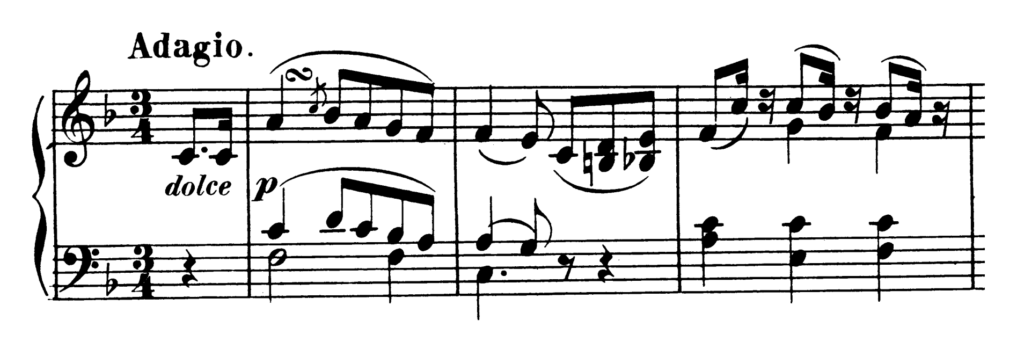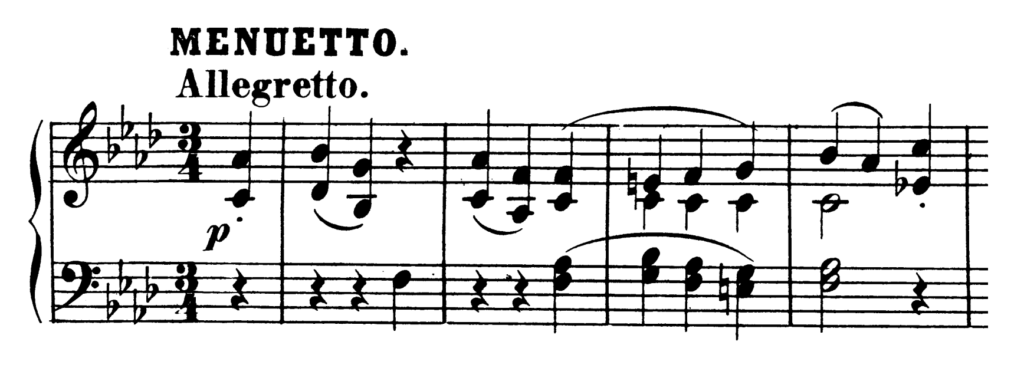Analysis
Contents
For the benefit of all pianists learning this work, we present to you a concise and easy to use analysis of Beethoven’s Piano Sonata No.1 in F minor.
First Movement (Allegro)
Form: Sonata Form. F minor
EXPOSITION:
Bars 1-9: 1st subject in F minor (tonic). The 1st subject ends at bar 9 on a half-close. It is written in 2-bar rhythm.
Bars 9-21: Connecting Episode. The connecting episode is principally based upon the 2nd and 3rd bars of the first subject.
Bars 21-42: 2nd subject in A flat major.
Bars 42-49: Coda.
Double bar and repeat.
DEVELOPMENT:
Bars 50-103: The development refers to both subjects. The first subject, which was originally in 2-bar rhythm occurs here, Bars 50-56, in 3-bar rhythm. A pedal point of some length, Bars 83-96, leads to the recapitulation.
RECAPITULATION:
Bars 103-110: First subject in original key.
Bars 110-121: Connecting episode. The connecting episodes is slightly altered; the beginning of it is transposed into the tonic key
Bars 121-142: Second subject in tonic key.
Bars 142-End: Coda. The Coda very much resembles that in the exposition, transposed into the tonic key and slightly elongated.
Second Movement (Adagio)
Form: Modified Rondo Form. F major.
PART I:
Bars 1-17: First subject in tonic key. The first subject ends with a full close on the tonic. it is adapted from an early Pianoforte Quartet.
PART II:
Bars 17-23: Connecting episode.
Bars 24-32: 2nd subject in C major. The latter part of the second subject is developed from Bars 2 and 3 of the first subject.
Bar 32: There is no development – Bar 32 modulates back to tonic key.
PART III:
Bars 33-48: First subject in original key. The first subject re-appears considerably varied, although the harmony remains almost unaltered.
CODA:
Bars 49-57: Second subject in tonic key. The second subject is transposed to tonic key, slightly varied.
Bar 57-End: Coda.
Third Movement (Allegretto)
Form: Ternary Form. F minor
FIRST PART:
Bars 1-15: First subject in F minor (tonic), ending in A flat major. The fist subject commences in F minor with a four-bar phrase, which is repeated, Bars 5-9, in the relative major; it ends with another four-bar phrase, Bar 9-13. The right hand parts of Bars 7-9 are inverted, Bar 9-11. Bars 11-13 are repeated.
Bars 16-30: Development. The development refers to the fist subject.
Bars 30-42: First subject beginning and ending in tonic key. The first subject re-appears, varied and shortened, and altered so as to end in the tonic key.
Double bar and repeat.
SECOND PART:
Bars 1-11: First subject in F major, ending in C major. The Trio contains many instances of inverting the parts. Compare Bars 6-8 (in the bass) with Bars 2-4 (in the treble).
Double bar and repeat.
Bars 12-27: Development. The first subject is referred to in the development; the parts are again inverted. Compare Bars 17-19 with Bars 13-15.
Bars 28-35: Fist subject beginning and ending in tonic key. The first subject re-appears slightly shortened, and altered so as to end in the tonic key instead of the dominant key as before.
Double bar and repeat.
THIRD PART:
First Part. Da Capo.
Fourth Movement (Prestissimo)
Form: Sonata Form. F minor
SONATA FORM – The long episode in the “development” as caused this movement to be sometimes described as being in Rondo form, but if it were in Rondo form, the Exposition would have ended in the tonic key with a return of the first subject.
EXPOSITION:
Bars 1-10: First subject in F minor (Tonic). The first part of Bar 1 is introductory. The rhythm of the first subject commences upon the third beat of the bar. The first subject ends upon the dominant chord.
Bars 10-23: Connecting episode. The connecting episode commences in the tonic key with the second part of the first subject, followed by the first part of that same subject in the key of G (dominant of the second subject), five bars on the dominant 7th of the key of C minor lead into the second subject.
Bars 23-51: Second subject in C minor. The second subject, instead of being in the relative major key, is in the dominant minor; it contains two distinct themes, Bars 23-35 and Bars 35-51, both ending with a full close.
Bars 51-57: Coda. The Coda is based upon the first subject.
Double bar and repeat.
DEVELOPMENT:
Bars 60-144: The development begins after two introductory bars, with an episode in A flat major, Bars 62-112, the real “working out” being between Bars 112-141.
RECAPITULATION:
Bars 141-149: First subject in original key. The first subject re-appears unaltered.
Bars 149-164: Connecting Episode. The connecting episode is for the most part exactly like that in the “Exposition,” transposed so as to lead into the key of the tonic.
Bars 164-192: Second subject in tonic key. The second subject re-appears slightly varied, and transposed to the tonic key.
Bars 192-End: Coda. The Coda consists entirely of a varied repetition of the commencement of the first subject.










